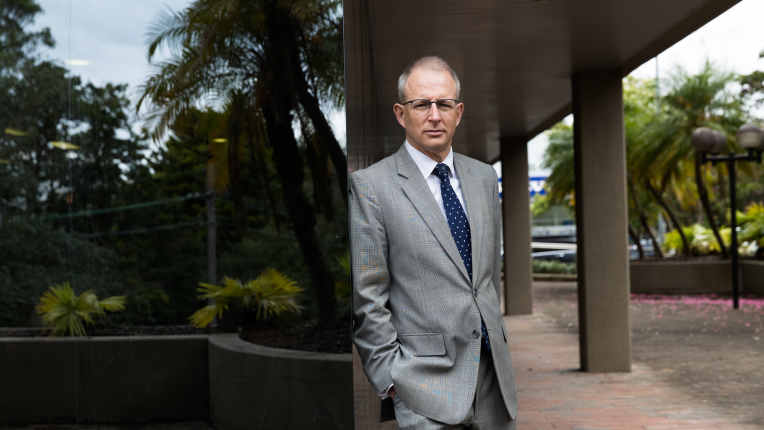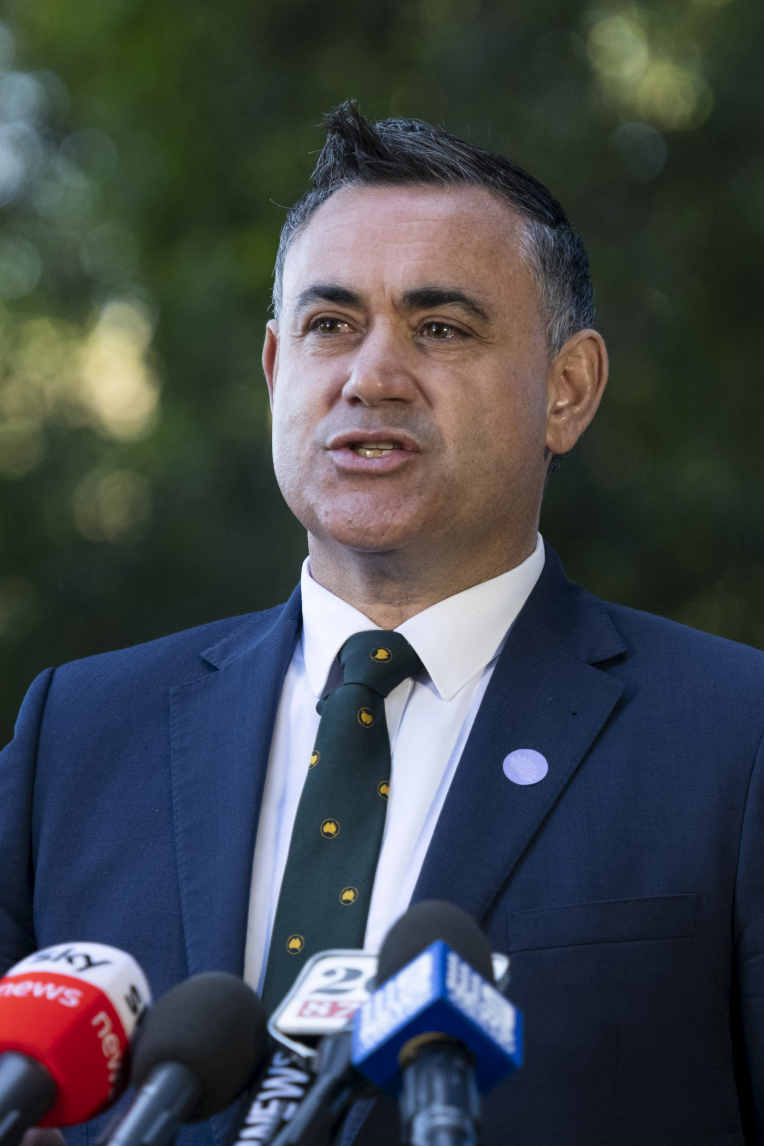Door opens for Telstra as NBN 'proves itself' in lockdown
by Paul SmithCommunications Minister Paul Fletcher has left the door open for Telstra's infrastructure arm to acquire the National Broadband Network in future, and said he was unconcerned by emerging competition from state government and privately owned rivals as the network had proven its value to most citizens during the COVID-19 lockdown.
In an interview with The Australian Financial Review, Mr Fletcher said the NBN had withstood a huge spike in usage as workers and students operated remotely and that NBN Co was now well positioned to upgrade for future needs after securing a $6.1 billion debt facility earlier this month.

His comments will prick the ears of Telstra CEO Andy Penn, who has long harboured plans to try and buy back the wholesale revenues lost to the NBN. They will also interest critics of the NBN rollout, who have complained about a lack of an upgrade plan after the completion of the initial rollout next month.
Mr Fletcher said the ability of NBN to raise significantly more debt than the $2 billion it had initially intended, had proved doubters of the multi-technology-mix (MTM) network's financial viability wrong.
He said it gave extra flexibility to NBN's management when repaying its debts to the Commonwealth and in planning possible technology upgrades.
This could mean NBN leadership moving areas off fibre-to-the-node (FTTN) to fibre-to-the-curb or premise (FTTP) where it identified a commercial demand.
"Amongst other things, that [debt raising] shows a level of confidence from the markets in the operational model and in the cash flows. Obviously, there's nothing that debt financiers look at more carefully than cash flows, and the direction of those cash flows," he said.
"They've now got additional financial resources through the debt, and we've said, amongst things they could do with that, is to pursue positive return on investment opportunity.
"We've been very serious about NBN having a professional, capable board and management. It's their job to understand, identify the market, customer behaviour, what the technical possibilities are, and crystallise that into particular proposals. What those might be is for them to develop.
Most people don't know what particular technology is being used to deliver their connection.
— Paul Fletcher, Communications Minister
"The corporate plan has 4.5 billion dollars in it for upgrading the network ... There's a bit of a myth spread by our political opponents that it's frozen in time. Not true at all. Any responsible board and management is going to build in upgrading of network capability."
Mr Fletcher has previously downplayed the possibility of Telstra acquiring the NBN, due to legislation forbidding the owner of the wholesale network from also being a retailer.
Despite Telstra creating a separate division called InfraCo, which many view as a potential home for a privatised NBN, Mr Fletcher has previously said he was "unable to see any scenario," where it could be allowed to become the owner of the wholesale network.
However, despite reiterating the laws around wholesale and retail ownership, Mr Fletcher now suggested it could be possible, when asked about InfraCo being spun off by Telstra as a separately listed company.
"It continues to be our policy, as it was Labor's policy, that in due course NBN will transfer to the private sector. There's a series of steps set out in the Act that would have to occur. We're not even at the first step yet. So, it's going to be sometime before privatisation is happening, but that certainly is the ultimate direction," Mr Fletcher said.
"I'll leave it to Telstra's bankers and lawyers to dream up structures. But the position is clear, if you operate retail telecommunication services, there's a barrier that applies to your acquiring NBN. If you don't, then that particular barrier does not apply.
"No doubt Telstra is very well placed to employ high-priced legal and investment banking talent should they be interested in pursuing the matter."
Mr Penn was approached for comment, but declined. He has previously told the Financial Review he wants Telstra to be involved in any discussions around privatisation.
A sale of the NBN would open up huge debate about its value, versus the amount spent by the government in building it. In March a Parliamentary Budget Office report into the financing of government projects, quoted a "fair value" estimate of NBN Co of just $8.7 billion at 30 June 2019.
The government has invested $29.5 billion in the project, as well as a $19.5 billion loan that NBN is due to refinance in 2024.
The rollout of the NBN has been mired in political fighting since it was first announced by Labor communications minister Stephen Conroy and prime minister Kevin Rudd in 2009 as a $43 billion largely fibre to the premise network.
The Coalition controversially changed this to favour a so-called multi-technology-mix, which included a large portion of slower fibre to the node technology, which was cheaper and quicker to deploy.
Ahead of the 2013 election, the Coalition claimed it would provide all Australians access to 25 megabits per second download speeds by 2016, before pushing back its projections in a strategic review conducted after it came to power.
With NBN due to hit its own measure for officially declaring the initial rollout complete next month, Mr Fletcher said it had "come of age" as the nation’s digital backbone for productivity, social cohesion and connectivity.

Had Labor's full fibre plan been allowed to proceed, he said it would have left a significantly larger portion of the population still on outdated ADSL services, and unable to reliably function during lockdown.
Mr Fletcher said Australians' data use had skyrocketed from 11 gigabytes a month in 2010 to the high hundreds at the end of last year, before hitting 303 gigabytes in March. Citing internal Communications Department projections, he forecast monthly average data downloads of 767 gigabytes a month by 2028.
On Friday, the Australian Competition and Consumer Commission released the first of its monthly reports on the NBN's performance. It found speeds had dropped off notably at the start of the lockdown period, before NBN gave retail service providers (RSPs) an extra 40 per cent of capacity for free to help manage the pandemic surge.
Average download speeds on NBN Co’s 50 Mbps and 100 Mbps speed tiers had dropped by 14 per cent and 23 per cent, respectively, before the move.
NBN's largesse with free capacity is due to end at the end of July, and it is under pressure to increase its average revenue per customer from $45 a month to $49 per month by 2023 in order to make enough money to remain "off budget," in terms of the nation's finances.
Mr Fletcher said citizens had seen during lockdown that the NBN was capable of delivering good performance, and that it was now up to NBN and service providers like Telstra, Optus, TPG, Vocus and Aussie Broadband to get together and strike a commercial balance that would guarantee these service levels.
"What I'd say is, that'll be the task for board and management. I thought they handled the challenge of COVID-19 very well, the jump in demand. What I anticipate is the discussions they'll have with their customers, the RSPs, will be against a backdrop of both parties to this discussion having a higher confidence about traffic levels for the future," he said.
"I'll confine myself to saying that, but I am reasonably optimistic that they'll be able to work commercially with the RSPs on what the construct looks like as they transition out of the particular COVID-19 pricing arrangements."
Shadow communications spokesperson Michelle Rowland said the COVID-19 pricing changes came after Labor advocated for industry assistance in meeting demand.
She said the challenge for internet providers was that they sell unlimited data plans at a fixed price, but the wholesale product they buy from NBN has a variable charge based on traffic volumes. She said that in reality it cost NBN little to un-throttle the capacity needed to support data growth, but it costs retail providers a lot to buy it in normal times.
"The question from here is how do we transition to a new normal in a fair and economically responsible way?" Ms Rowland said.

"I suspect hastily reversing the capacity boost would be unwise given this could force up prices or lead to congestion ... Labor would prefer to see a considered transition of NBN capacity pricing in consultation with retail providers, informed by traffic trends as restrictions wind down.”
Despite arguments about the errors in a shift from Labor's NBN policy to the Coalition's among the technically minded, policies of both major parties towards the future of the network were largely the same at last year's election.
Mr Fletcher said he knew there were people who would never believe that it had been right to change, but that he had been a senior Optus executive prior to entering politics and had been shocked at the operations of NBN Co inherited from Labor.
He was parliamentary secretary to Malcolm Turnbull as communications minister, and said Labor's public rhetoric about the progress of its full fibre rollout was not reflected in the reality behind the scenes.
He said he stood by the intention of the switch to multi-technology mix, which was to deliver an affordable, high-speed broadband network as quickly as possible, before upgrading when necessary and feasible.
"There remains a group of people, in my estimation, a somewhat shrinking group of people, who hold with a near-religious fervour to a particular network rollout, and network architecture ... Our focus has very much been on the mass market, and what customers want," Mr Fletcher said.
"For the great majority of Australians, they don't care about these involved debates about network architecture. Most people don't know what particular technology is being used to deliver their connection. What they care about is the speeds they get from a network speed test, whether Netflix is freezing and whether it holds up when they have multiple people at home working."
Former NBN Co chief technology officer Gary McLaren, who was instrumental in designing Labor's rollout said he was pleased to hear Mr Fletcher talking about upgrades to the NBN, but said it also amounted to an admission that the government had earlier made errors.
He said there were some customers who had benefited moving off the old ADSL networks before COVID-19 hit. But that NBN Co was still approximately 1 million active customers shy of its 8 million by mid-2020 target set under under former NBN CEO Bill Morrow.
"I find it hard to fathom how NBN can make a good case for a technology upgrade without admitting they have wasted investment in the wrong technologies. It would mean that they have either underestimated the operational cost of FTTN or HFC or underestimated the competitive threat from 4G and 5G competition," Mr McLaren said.
"Both of these would be difficult from a financial and political perspective. Financially it would require a write-off of the capex investment well ahead of the expected depreciation, and/or an admission that NBN’s prices are too high.
"Politically it would be a big back down given all the statements that FTTN and HFC would satisfy all that customers desire."
Increased competition
One thing that is clear about the Coalition's move from a full fibre network to the MTM is that it has opened the door for more competition. NBN will face fierce competition from the likes of Telstra, Optus and TPG's fixed wireless services in major cities, and specialist FTTP providers, like DGtek in Melbourne, are luring some heavy users away.
The NBN could also surprisingly lose business to state government-owned networks. In South Australia, the City of Adelaide has had a GigCity fibre network program since 2018, and in New South Wales the Liberal government announced market testing for a new $100 million "Gig State" initiative in March.
This is aimed at delivering increased internet capacity and faster, more reliable internet services to central business areas in regional NSW. The NSW announcement said initial deployment will be in Dubbo, Wagga Wagga, Parkes and a corridor west to Cobar.
Fibre solutions will also be created for residents in Sutton, Bywong and Wamboin. The project will then be rolled out across more of regional NSW.
Mr Fletcher said NBN was more concerned with rivalry from 5G than other fixed-line options, and said expectations of competition were factored into NBN's business plan.
"We are not paranoid about or hostile to competition, quite the contrary. I welcome competition," he said.
"The initial locations for Gig State, NBN is already there ... It is a matter for the NSW government, but we have worked closely with them on things like mobile black spots, and have successfully deployed Commonwealth and state money together to deliver a network rollout that went further than otherwise possible.
"They're trying a different strategy and I've got no problem with that ... Of course, we will continue to see both public and private network investment targeting particular geographic markets and country towns and regions. That is good, that is all to be desired."
Asked about the potential for competing against his federal colleagues' NBN, NSW Deputy Premier John Barilaro, who is responsible for Gig State under his portfolio as minister for regional NSW, sought to downplay any conflict.
He said events, such as the recent bushfires and COVID-19 had underscored how important it was to stay connected in a digital world, and his policy sought expressions of interest (EOIs) about how it could be done.
"Gig State is all about achieving outcomes for people living in the bush who have put up with patchy internet for years. The program’s objectives are intentionally ambitious, as the NSW government wants to see improvements in internet speed, affordability and reliability," Mr Barilaro said.
"Gig State is not about any one particular provider. The EOI, released in April, seeks market feedback and calls on all interested parties to pitch their best, most innovative digital ideas."
As part of the recognition that customers want higher speeds, Mr Fletcher revealed that NBN will unveil new pricing tiers at the end of this week, but declined to go into specific details ahead of the company's announcement.
NBN released a test agreement for new residential high-speed services in March, known as Home Fast, Home Superfast and Home Ultrafast, which looks like the basis for the plans.
"There are a lot of things coming down the runway. This week NBN is going to launch new pricing, markedly lower pricing for ultrafast services ... of 250 meg and speeds of near to a gig," he said.
"So whichever parts of the network are capable of it, obviously starting with fibre to the premises, it will be about demonstrating to Australians there are significant parts of this network that can do much faster speeds ... The pricing is going to be much more attractive, and there is going to be the continuing development of and demonstration of the capability of the network."